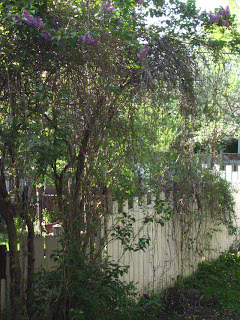
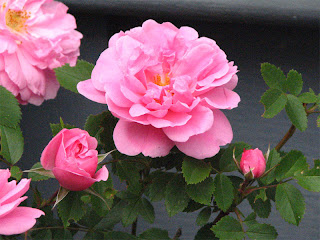




 two hostas who survived the move
two hostas who survived the move
 Southern Elder, taking nicely to it's new home along the west fence
Southern Elder, taking nicely to it's new home along the west fence
Not all in the first sketch have been planted yet (or in some cases found & bought yet, like raspberry canes and a rhubarb for behind the shed). I'd like to think of this as a reasonable (rough) plan for the coming months. Most of these are here, some planted - along with a flash mob of sweet peas that I planted and left in the warm porch (they need to be planted, and will be along the back fence). There will be other perennials - a lady's mantle near the spruce for instance, and the rudbeckia isn't sketched in, nor is the veronica, a snowmound spirea will be planted but I don't know where. I'm just drawin'.

Structurally, I have projects like a compost bin that I'd like to complete sooner than later, one that I've designed myself of wood planks and heavy mesh; the location for which has been designated in an awkward area between the shed and the location for the small greenhouse, the ramp into the shed, and the westward neighbors fence. It's out of the way but accessible, perfect. 
The maximilian sunflower (Given to me by a greenhouse customer who had once come into the gh hoping for some "gardening advice" but took one took at me, wrongly assumed my youthful appearance equaled youthful naivety, and *almost* insulted me with his questions until he realized I knew what I was talking about, gave me credit for that, and took my advice. He returned a week or so later with a big pot of the sunflower, which he had devided from the one growing in his yard. He gave it to me to apologize for judging me, and to thank me for our conversation.) is growing happily from behind the compost, between the shed and the fence. I wasn't worried about it surviving (it's far too hardy to have much trouble), but I have to say that I'm happy to see it again, always warmed by what it represents.
I did some amending and planting last night. The Annabell Hydrangea is finally in it's place, along with a Hosta 'High Society', an Astilbe: Thunbergii (False Spirea) 'Straussenfeder' surrounded by two Pulmonaria (Boraginaceae) (Lungwort). Closer to the space between where the neighbors draping Lilac/Virginia Creeper meet the crawling Hops, near the Southern Elder, I planted an Aruncus Dioicus (Goat's Beard); between the two I hope to plant a Solomon's Seal (don't have it yet tho).
Amended and planted the tomatoes (my Grape and Hannah's mystery-school-trip-tomato-plant).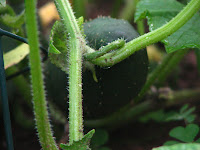 I also planted Hannah's strawberry plant in a good area near the garden egde (so that she can reach the berries easily) - I have to go find a wire cage to keep is safe from nastysquirrels as soon as possible, or we'll miss out! Between all this and along the garden border, as usual, cucumbers will curl and twist. I loved how they appeared everywhere through my garden last year, climbing the strawberry cage, and weaving through the peas all the way to the path and beyond - perhaps it was unruly behavior (for a cucumber), but it was funny to me, and the yeild was fantastic ;).
I also planted Hannah's strawberry plant in a good area near the garden egde (so that she can reach the berries easily) - I have to go find a wire cage to keep is safe from nastysquirrels as soon as possible, or we'll miss out! Between all this and along the garden border, as usual, cucumbers will curl and twist. I loved how they appeared everywhere through my garden last year, climbing the strawberry cage, and weaving through the peas all the way to the path and beyond - perhaps it was unruly behavior (for a cucumber), but it was funny to me, and the yeild was fantastic ;).
On Saturday, working at the main greenhouse rather than at the 55+ Centre, I was climbing tables, playing with perennials, listened to schmultzy easy listening until I felt like mush inside, and topped the day off with wine with Sue & Dennis under the bubble. It was the greenhouse at it's best (as far as my enjoyment with it this season) - I realy enjoyed being at the main greenhouse, and was sad to have passed the season without it. So, I made the most of it. It was busy. I was busy. I feel great.
John Davis is blooming on the East side of the front steps. He's a little gangly, a side effect from the move for sure - I'll have to prune him well. For now though, I don't want to disturb him, or any of the other roses until they've had a longer time to get comfortable. Poor Morden Fireglow is blooming in his pot right now because I've not found the time to plant that bed yet. It's easier to imagine the shrubs in bloom now, more full - next year; I look forward to it.
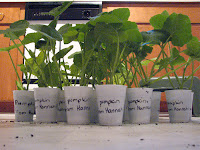 Tomorrow his Hannah's last day of 3rd grade. She'll be bringing pumpkin plants to all the children in her class. I hope the parents don't mind. Tomatoes and flowers are one thing - a vine that will take over a good portion of a yard is another. Ah well, it'll be fun for the moment. I brought a couple plants for Cooper, my neighbor - aged 3, who likes to ask me lots of questions over the fence while I dig and photograph my yard take meeeee! take pictuuure of mee tooo! take meeee! he yells over the fence, along with what are you doing? what are you doing now? what are you doing? what are you doing now? what are you doing? which is said so utterly adorably, no blogged words could do him justice.
Tomorrow his Hannah's last day of 3rd grade. She'll be bringing pumpkin plants to all the children in her class. I hope the parents don't mind. Tomatoes and flowers are one thing - a vine that will take over a good portion of a yard is another. Ah well, it'll be fun for the moment. I brought a couple plants for Cooper, my neighbor - aged 3, who likes to ask me lots of questions over the fence while I dig and photograph my yard take meeeee! take pictuuure of mee tooo! take meeee! he yells over the fence, along with what are you doing? what are you doing now? what are you doing? what are you doing now? what are you doing? which is said so utterly adorably, no blogged words could do him justice.
Last night, my dirty digging self was compared to a dirty digging Cooper (shortly before his bath) by his visiting uncle. Some might cringe at the thought, but I love being covered in earth: my hands feeling soil all around them crumbling, fingers like earthworms my feet bare and black with earth that soils the floor and the bathtub my bare legs exfloliated by the texture - who wouldn't love that? I was really dirty last night. The soil is loamy, but cool and damp.
My paper on urban forestry has led me back to The Lorax by Dr. Suess. grin.
It's past my bedtime. Goudanight, sleep tight, don't let the space bugs bite.
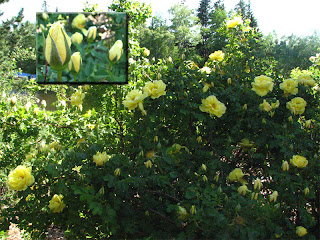 Hazeldean, an old fashioned hybrid rose, with multiples of gorgeous yellow blooms. This campus shrub is currently covered in large buds and bloom after bloom which fill the air with their sweet spicey fragrance.
Hazeldean, an old fashioned hybrid rose, with multiples of gorgeous yellow blooms. This campus shrub is currently covered in large buds and bloom after bloom which fill the air with their sweet spicey fragrance.WHEN I see birches bend to left and right 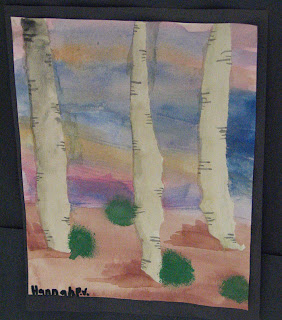
Across the line of straighter darker trees,
I like to think some boy's been swinging them.
But swinging doesn't bend them down to stay.
Ice-storms do that. Often you must have seen them
Loaded with ice a sunny winter morning
After a rain. They click upon themselves
As the breeze rises, and turn many-colored
As the stir cracks and crazes their enamel.
Soon the sun's warmth makes them shed crystal shells Shattering and avalanching on the snow-crust—
Such heaps of broken glass to sweep away
You'd think the inner dome of heaven had fallen.
They are dragged to the withered bracken by the load, And they seem not to break; though once they are bowed
So low for long, they never right themselves:
You may see their trunks arching in the woods
Years afterwards, trailing their leaves on the ground
Like girls on hands and knees that throw their hair
Before them over their heads to dry in the sun.
But I was going to say when Truth broke in
With all her matter-of-fact about the ice-storm
(Now am I free to be poetical?)
I should prefer to have some boy bend them
As he went out and in to fetch the cows—
Some boy too far from town to learn baseball,
Whose only play was what he found himself,
Summer or winter, and could play alone.
One by one he subdued his father's trees
By riding them down over and over again
Until he took the stiffness out of them,
And not one but hung limp, not one was left
For him to conquer. He learned all there was
To learn about not launching out too soon
And so not carrying the tree away
Clear to the ground. He always kept his poise
To the top branches, climbing carefully
With the same pains you use to fill a cup
Up to the brim, and even above the brim.
Then he flung outward, feet first, with a swish,
Kicking his way down through the air to the ground.
So was I once myself a swinger of birches;
And so I dream of going back to be.
It's when I'm weary of considerations,
And life is too much like a pathless wood
Where your face burns and tickles with the cobwebs
Broken across it, and one eye is weeping
From a twig's having lashed across it open.
I'd like to get away from earth awhile
And then come back to it and begin over.
May no fate wilfully misunderstand me
And half grant what I wish and snatch me away
Not to return. Earth's the right place for love:
I don't know where it's likely to go better.
I'd like to go by climbing a birch tree,
And climb black branches up a snow-white trunk
Toward heaven, till the tree could bear no more,
But dipped its top and set me down again.
That would be good both going and coming back.
One could do worse than be a swinger of birches.
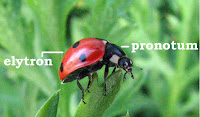 and widespread in North America. Adults and larvae prey on aphids in open habitats. Adults are active in spring and dormant in summer; they hibernate in large aggregations in winter.
and widespread in North America. Adults and larvae prey on aphids in open habitats. Adults are active in spring and dormant in summer; they hibernate in large aggregations in winter.container: purple millet, sweet potato vines, fountain grass... strange fruit in the neighbors tree...
strange fruit in the neighbors tree...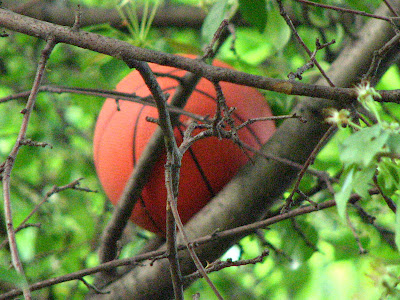
Graboski, Jason, Nina Bassuk, Peter Trowbridge. "Structural Soils: A New Medium to Allow Urban Trees to Grow in Pavement". LATIS, American Society of Landscape Architects. Washington, 2002.
(pdf)
Green Streets Canada is a flagship program of the Tree Canada Foundation – the only nationally based municipal forestry innovation program. With a total of 345 municipalities (including Thunder Bay's Tree Stewardship Program) participating since its inception in 1994, the program was in 2006-2007 sponsored by the Canadian Forest Service, Natural Resources Canada, Trans Canada and BC Hydro.
The purpose of the Program is to encourage the adoption of innovative best management practices and policies in municipal forest management on as wide a regional basis as possible.
Thunder Bay Tree Stewardship Program's Tree Care Guide .
What Trees Can Do to Prevent Atmospheric Co2 (a Tree Canada Foundation publication)
The Canadian Urban Forest Network Compendium of Best Management Practices for Canadian Urban Forests *resources
The Ontario Urban Forest Council
For Kids (and teachers) from TreeCanada.ca
Teaching Older Children and Youth about Trees
Greening Canada's School Grounds (a Tree Canada Foundation publication)
from http://www.treesaregood.com/
MYTH #1: When a tree is planted it should be securely staked to ensure the development of a stable root system and a strong trunk. Although it is sometimes necessary to stake trees to keep them upright and allow establishment, there are some adverse effects of staking. Compared to staked trees, unstaked trees tend to develop a more extensive root system and better trunk taper. Allowing a small amount of movement can help root and trunk development. Of course, the worst effect of staking is the possibility of trunk damage from the staking wires or ties. Staking materials usually should be removed after one year to avoid "girdling" the tree.
MYTH #2: Newly planted trees should have their trunks wrapped with tree wrap to prevent sunscald and insect entry. Studies using most common tree wraps have shown that they do not prevent extreme fluctuations in temperature on the bark. In some cases, the temperature extremes are worse. Also, tree wraps have proven quite ineffective in preventing insect entry. In fact, some insects like to burrow under it.
MYTH #3: Trees should be pruned back heavily when they are planted to compensate for the loss of roots. Tree establishment is best with unpruned trees. Although pruning the top can reduce the amount of water that evaporates from the leaves, the tree needs a full crown to produce the much-needed food and the plant hormones that induce root growth. The tree will develop a stronger, more extensive root system if it has a fuller crown. Limit pruning at the time of planting to structural training and the removal of damaged branches.
MYTH #4: When removing a branch from a tree, the final cut should be flush with the stem to optimize healing. First of all, trees don't "heal" in the sense that wounds on people heal. Our bodies regenerate tissues in much the same form of the tissues that were removed (to a limited extent). Trees compartmentalize wounds, generating woundwood over the wounded area. Flush cutting removes the "branch collar," creating a larger wound than if the branch were removed outside the collar. Also, it is likely that some of the parent branch tissue will be removed. The spread of decay inside the tree is greater with flush cuts.
MYTH #5: Pruning wounds greater than three inches in diameter should be painted with a wound dressing. Research has shown that the common wound dressings do not inhibit decay, do not prevent insect entry, and do not bring about faster wound closure. In fact, many of the commonly used dressings slow wound closure.
MYTH #6: Certain fast-growing, weak-wooded trees such as silver maple and Siberian elm should be "topped" to make them less hazardous in the landscape. While topping these trees may reduce the potential hazard at first, they will likely be more dangerous in the future. Topping stimulates growth of twigs below the cuts. Growth of many, vigorous shoots leads to branches with weak attachments. Also decay spreads inside the stubs and branches that were topped. Within 2-5 years after topping, the tree will have regained its height, but will be more hazardous than before the topping. Besides, topping makes trees ugly. Alternatives to topping include thinning, cabling, or removal and replacement with a more suitable species.
MYTH #7: If certain species of trees are pruned early in the spring, they will "bleed," stressing the tree and causing health problems. True, some trees such as maples and birches will "bleed" or lose sap from pruning cuts made early in the spring. This bleeding does not hurt the tree, and the loss of sap is inconsequential. With a few exceptions, most routine pruning can be done anytime of year. The worst time is just as the tree has leafed out in the spring. The best time is when the tree is dormant. To maximize flowering for the following year, prune just after bloom this year.
MYTH #8: The root system of a tree is a mirror image of the top. Many people envision a large, branching taproot growing deep into the soil. Actually, taproots are very uncommon in mature trees. If taproots do develop, they usually will be forced into horizontal growth when they encounter hard subsoils beneath the surface. The entire root systems of most trees can be found within three feet of soil. The spread of the root system however, can be very extensive, often extending 2-3 times the spread of the crown.
MYTH #9: Trees require "deep root fertilization" to reach their root system. In most soils, the vast majority of trees' fibrous, absorbing roots are in the top eight inches of soil. Roots grow where conditions are best for root growth, where water and oxygen are available. When we place fertilizer 12" - 18" deep in the soil, we are putting it too deep.
MYTH #10: When a tree has lost a significant portion of its root system such as in construction damage, the crown should be cut back to compensate for root loss. While this is a common recommendation, research has not supported it. Following root loss, unpruned trees seem to respond better than pruned trees. Obviously, any removal of branches will reduce the capacity of the tree to produce food in the leaves. Although the tree will probably lose some branches as a result of the root damage (if the tree survives the trauma), it is best to let the tree decide which ones. Thus, pruning should be limited to hazard reduction at first. Later, after the tree has responded to the damage, further pruning would be in order.
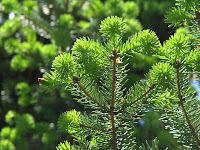
After consideration, I've decided to write about urban trees, specifically boulevard trees and their unfortunate soil conditions in northern climates (i.e. road salts). After the loss of yet another mature Birch on my block, and while watching our little Ash struggle to keep up with the rest I'm provoked to learn more about planting, maintenance, and the long term health of these very beneficial (and beautiful) members of our community.
 It's so sad to watch these enormous trees come down - thinking about how long it will take for their replacements to fill their void -
It's so sad to watch these enormous trees come down - thinking about how long it will take for their replacements to fill their void -
Although you may never sit in its shade, plant a tree for those who will.
SOURCES
 two pdf files:
two pdf files:
Tree Planting Guidelines
Canadian Trees eBook Vol. ONE, No. 1, 2004
...and a very helpful resource web page: Canadian Urban Forest Network (resources) (wow, what gardenerd loot!)
and I've ordered a copy of:
Ingram, David. Science and the Garden: The Scientific Basis of Horticultural Practice Blackwell Science Ltd (30 Jul 2002) ISBN 978-0632053087
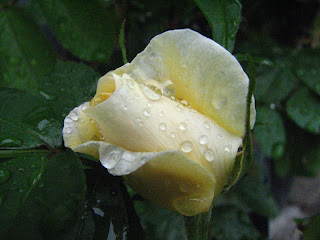
J.P. Connell opened a bud this morning, after a night of light rain.
